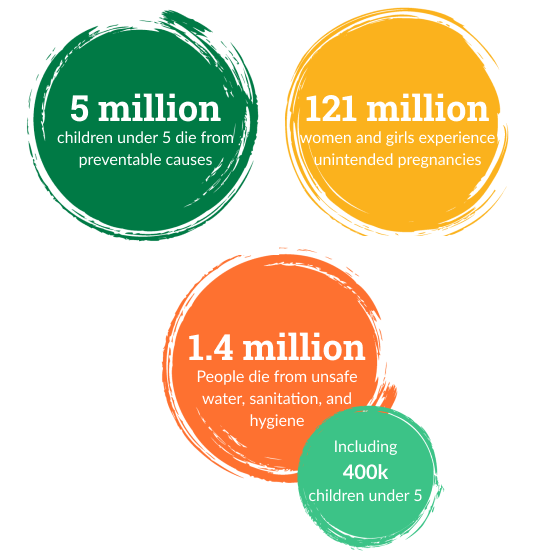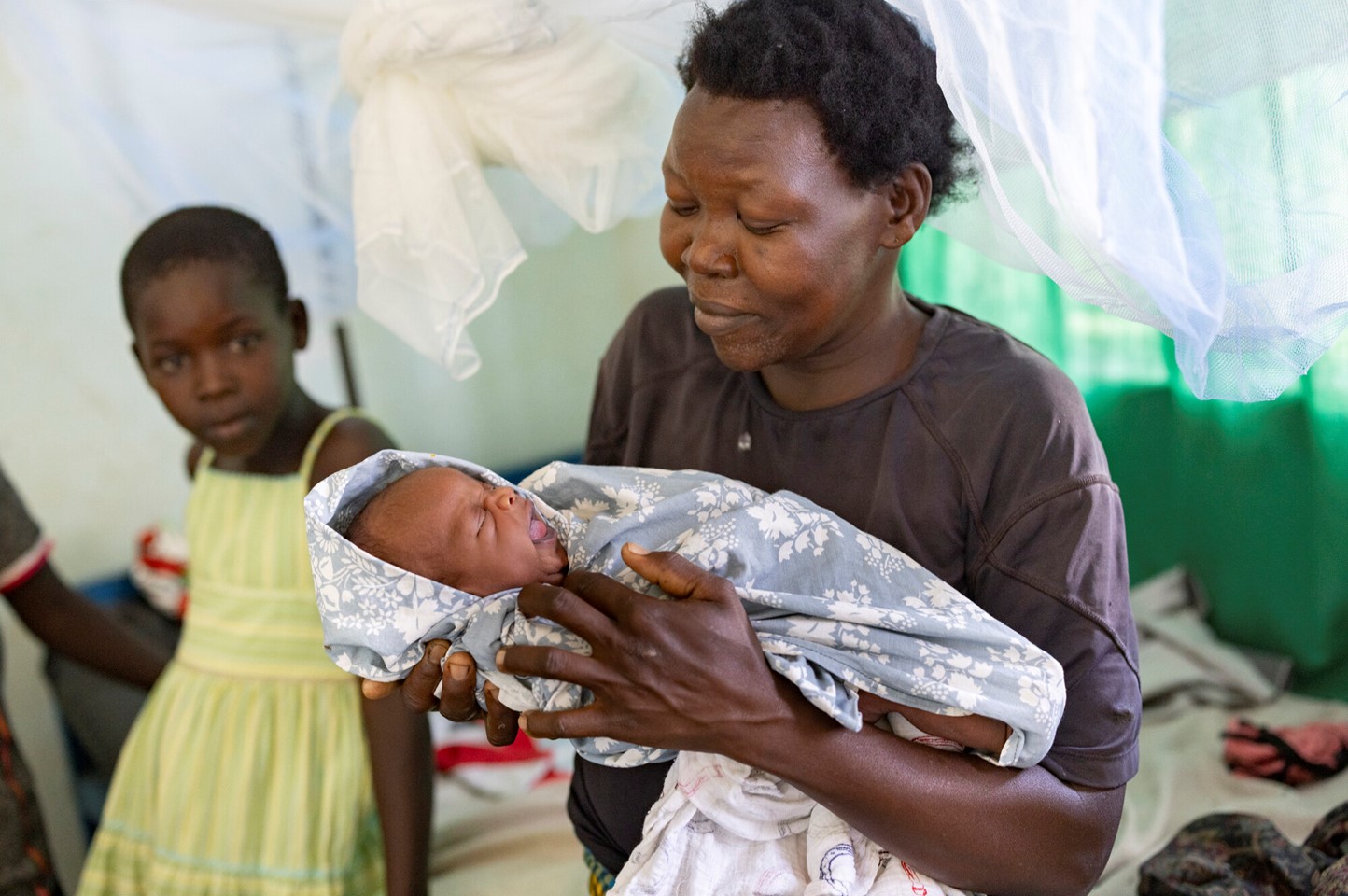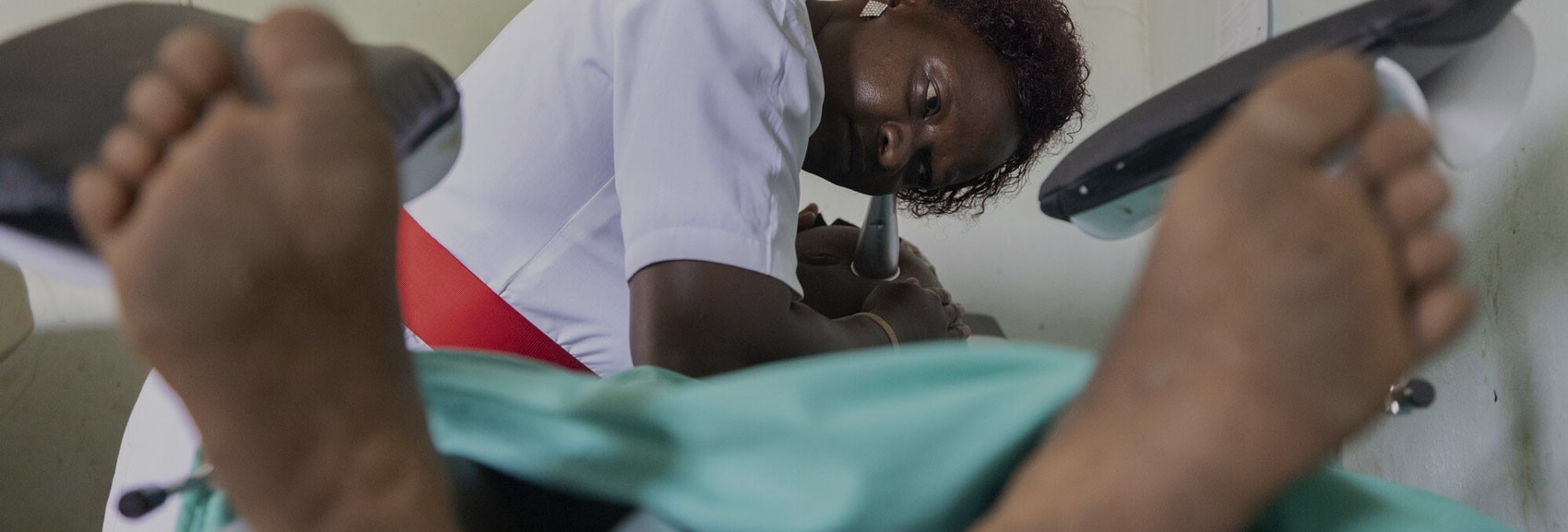
A lifetime of good
health begins in childhood.
But children in under-resourced communities face threats to their health, including malnutrition, communicable diseases and disparities in access to health care. Most of these threats, though often deadly, are completely preventable. So is the ensuing drain on local economies due to unnecessary health care costs and lost productivity.
Working through trusted local partner organizations, ChildFund supports communities as well as local and national health systems to address children’s health needs from before birth to young adulthood. Our programs focus on several intersecting areas, creating impact leading to lifelong health for children and families no matter where they are.
Maternal and Child Health
What are the drivers of poor health outcomes among mothers and children in under-resourced communities? There are many, including lack of access to quality care, malnutrition, poor sanitation and hygiene, low levels of health literacy and education, inequality and discrimination, weak health systems and other socioeconomic factors that create health disparities.
Strengthening health systems and promoting access to water, sanitation and hygiene as well as improvements to nutrition can go a long way toward keeping mothers and children healthy.
Leveraging community health workers
We train and deploy community health workers to provide antenatal care, education on safe delivery practices, and routine immunizations directly in communities, ensuring that even the most remote or marginalized populations have access to essential maternal and child health services.
Engaging community leaders and networks
We collaborate with local leaders, women's groups and community networks to promote the importance of antenatal care visits, immunizations and proper nutrition — and to advocate for safe deliveries, whether at home with a skilled birth attendant or in a health care facility.
Educating new mothers
Trained community health workers provide comprehensive education to new mothers on the importance of antenatal care, immunizations, proper nutrition and safe delivery practices, supporting them with the knowledge to make informed health decisions for themselves and their children.
Connecting mothers to essential services
We facilitate access to health care by linking new mothers with local health services, including skilled birth attendants, immunization programs and nutritional support, ensuring that they receive the care necessary for a healthy pregnancy and childbirth.
Featured Projects
The Busia Maternal Newborn & Childhood Survival Project | Uganda
Using a community-based engagement approach, this three-year project led to a decrease in childhood illnesses and increased awareness on pregnancy, delivery, postpartum and newborn danger signs.
Lessons Learned from a Strengthened Partnership for Nurturing Care 2018 – 2021
With funding from the Conrad Hilton Foundation, ChildFund led a multi-country initiative to address the needs of caregivers and their young children (3 and under) affected by HIV and AIDS in sub-Saharan Africa.
Child Health Innovation | Honduras
This USAID-funded project implemented community-based structures and strengthened the public health system, resulting in increased caregiver understanding of young-child health and when to seek care and assistance for births by qualified health workers or hospital deliveries.
Nutrition
Malnutrition is common in many regions where ChildFund works, where communities are particularly vulnerable due to poverty, food insecurity and limited access to health care. This makes nutrition programming critical for improving health outcomes, fostering economic development and thus stability. Proper nutrition programming can significantly reduce under-5 deaths and prevent diseases related to malnutrition for all children.
ChildFund’s approach reduces malnutrition by promoting healthy infant and young-child feeding practices, training and mobilizing community health workers to provide nutrition services, and connecting families with local health services. We often conduct our nutrition programming in tandem with early childhood development efforts, building on health and nutrition aspects of the Nurturing Care Framework.
Strengthening Health Systems
By integrating nutrition interventions into existing health systems, countries can ensure sustainable, equitable access to quality nutrition care, particularly for vulnerable populations. Strengthening health systems to improve nutrition involves addressing health care infrastructure, workforce and supply chains to deliver essential nutrition services, such as micronutrient supplementation, counseling and malnutrition treatment.
Reaching the Most Marginalized Groups
Ensuring equity when delivering community-based nutrition programs requires targeting the most vulnerable and marginalized populations, including women, children and those in remote areas, to address disparities in access to nutrition services. Tailoring interventions to meet the specific needs of diverse communities helps overcome obstacles and ensures that all individuals can achieve optimal nutrition and health outcomes.
Active Community Engagement
Mobilizing and training community health workers to regularly screen, identify and treat cases of acute malnutrition ensures early intervention and increases coverage of nutrition services, particularly in hard-to-reach areas.
Promotion of Infant and Young Child Feeding (IYCF) Practices
Educating caregivers on the importance of exclusive breastfeeding for the first six months and introducing nutrient-rich complementary foods thereafter can significantly improve child nutrition and reduce malnutrition rates. The Sustainable Nutrition Education and Health (SNEH) Project in India targeted children and pregnant and lactating women in 33 villages in Madhya Pradesh, resulting in a 96% reduction in malnutrition among children under 5. Learn More
Featured Projects
MUKTI TB Project | India
This innovative, results-based financing (RBF) initiative in Madhya Pradesh, India, included an intensive nutrition intervention, utilizing home visits, counseling, food basket distribution and assistance in obtaining government benefits to enhance the nutritional status of tuberculosis patients.
Ensuring Children’s Nutrition and Age-Appropriate Development in Mullaitivu Project (ECNAAD) | Sri Lanka
The integrated approach of this program considered the different factors that influence a child’s health and development, such as family health habits, personal and environmental hygiene, safe water and sanitation practices and food security. Results from the evaluation report showed that the percentage of children 0-5 years old who measured within the appropriate weight for their age increased from 36.61% to 91.7%.
Ensuring Health, Nutrition and Children’s Education (ENHANCE)
This multi-country project implemented in Indonesia, Sri Lanka and the Philippines reflects global efforts to strengthen and advocate for children’s access to quality nutrition, health, education and early childhood services. The endline survey found that 61% of malnourished children’s nutritional status improved.
Water, Sanitation and Hygiene
Poor sanitation and unsafe drinking water are major contributors to malnutrition and stunting in children. Inadequate water, sanitation and hygiene (WASH) infrastructure also contributes to the spread of waterborne diseases such as cholera, diarrhea and typhoid, which are leading causes of illness and death in low- and middle-income countries. According to the WHO, 1.4 million annual deaths could be prevented with safe WASH. Strengthening WASH systems in these areas is essential for improving public health, reducing disease transmission and fostering sustainable development. Investments in WASH programs also yield significant economic returns by creating healthier communities that can fully participate in economic activities.
ChildFund’s interventions to promote public health include improving access to water and sanitation facilities, supporting local water and sanitation committees to manage and maintain water sources, and educating children and families on the importance of safe water and healthy practices. We also work through local partners to establish robust monitoring and evaluation systems and support capacity-building for local authorities and service providers. All of this ensures the reliable and sustainable provision of WASH services, leading to better health outcomes and improved quality of life for communities.
Local Water and Sanitation Committees
Establishing and empowering local committees to oversee the management and maintenance of water sources and sanitation facilities ensures community involvement and ownership, which can improve the sustainability and effectiveness of WASH interventions.
Behavior Change Campaigns and Education
Implementing targeted education programs that promote the benefits of safely managed drinking water, proper sanitation and handwashing can shift community behaviors and increase the adoption of healthy practices. This includes training on the use and maintenance of facilities and the importance of hygiene.
Incentives and Support for Facility Upgrades
Providing financial and technical support to households, schools and health centers for upgrading to improved sanitation facilities and safe water systems, combined with incentives for adopting hand washing practices, can enhance access and encourage consistent use of WASH services.
Featured Projects
Community and School WASH project in Mukuru and Kasarani Informal Settlements, Nairobi | Kenya
The goal of this program was to deliver WASH interventions to improve waste disposal, increase access to and use of safe water, improve hygiene practices in households and decrease waterborne disease among children between 0-14 years. Learn More
WASH Project in Oromia Region | Ethiopia
This project addressed the lack of potable water in this region through restoring damaged boreholes and public water fountains, providing structure maintenance and promoting public health information on environmental sanitation. This led to improved access to safe water for the communities and public health awareness and hygiene promotion for more than 64,932 people affected by drought. Learn More
Nairobi WASH (Mazingira Bora) project | Kenya
This project provided water, sanitation and hygiene interventions aimed at improving management of waste disposal, increasing access to safe water and improving hygiene practices to decrease waterborne disease among children ages 0-14. Use of micro-membrane filters increased from 1% to 76.20%. Children’s water access increased from 77% to 89.7%, and the rate of water systems protected from contamination increased from 38% to 41%. Learn More
Procter & Gamble Children’s Safe Drinking Water Program (CSDW)
This program focused on increasing access to safe and clean drinking water for people using water from unprotected sources (earth dams, sand dams, hand-dug wells) and increasing community awareness and knowledge of the use of safe and clean water; impact groups of focus included children under 5 as well as people living with HIV or AIDS in an effort to reduce morbidity cases related to the consumption of unsafe water. The project helped to increase household use of treated water by 53% (from 46% to 99%). Learn More
Infectious Diseases
Malaria remains a leading or the leading cause of death for children under 5 in many of the countries in Africa where ChildFund operates. Tuberculosis is the leading infectious disease killer, surpassing COVID-19 worldwide.
Both diseases disproportionately affect vulnerable groups, including children under 5, pregnant women, people living with HIV, and those with weakened immune systems. Targeted programming helps protect these at-risk populations. Prevention and treatment can also help mitigate economic and social impacts, like reduced workforce productivity and rising health care costs.
ChildFund promotes infectious disease prevention and control by engaging and educating communities around preventive practices, as well as testing and treatment for malaria and tuberculosis and training community health workers to reach communities in the most remote areas.
Empowered Community Health Workers
Training and deploying local health workers to provide education, conduct testing and distribute preventive measures — like insecticide-treated bed nets — ensures that malaria and TB services reach even the most remote and underserved populations.
Community Outreach Programs
Conducting regular outreach in rural and hard-to-reach areas improves access to malaria and TB testing, diagnosis and treatment, reducing the disease burden by identifying and treating cases early.
Community Engagement and Education
Involving community leaders and members in awareness campaigns and educational programs helps build trust, encourages preventive practices, and ensures that individuals seek timely testing and treatment for malaria and TB. Community participation strengthens the capacities of health systems to prevent and control tuberculosis and allows a better understanding of the disease from the patient and community perspectives.
Featured Projects
MUKTI TB Project | India
This innovative, results-based financing (RBF) initiative in Madhya Pradesh, India, included an intensive nutrition intervention, including home visits, counseling, food basket distribution and assistance in obtaining government benefits to enhance the nutritional status of tuberculosis patients. Learn More
Busia Maternal Newborn & Childhood Survival (MNCH) Project | Uganda
This intervention contributed to improved knowledge of positive pregnancy, postpartum and family health care, including the importance of early childhood immunization. Women aged 15-49 who knew at least four maternal danger signs during pregnancy increased by 13%, and mothers aware of at least four key child family health care practices (such as immunization) increased by 29%. Learn More | Evidence Snapshot

We used to worry so much about water, but now that burden has been lifted.
— Carmen, mom of Yuridia, 7, Mexico
Explore Our Impact
-

Helping moms & babies thrive in Uganda
Using a community-based engagement approach, the three-year Busia Maternal Newborn & Childhood Survival Project in Uganda led to a decrease in childhood illnesses, as well as increased awareness on pregnancy, delivery, postpartum and newborn danger signs.
-

Enhancing access to nutrition in Asia
The Ensuring Health, Nutrition and Children’s Education (ENHANCE) project, implemented in Indonesia, Sri Lanka and the Philippines, reflects global efforts to advocate for children’s access to quality nutrition, health, education and early childhood services. The endline survey found that 61% of malnourished children’s nutritional status improved.
-

Removing barriers to clean drinking water
Our partnership with Procter & Gamble Children’s Safe Drinking Water Program (CSDW) focused on increasing access to safe and clean drinking water for people using water from unprotected sources and increasing community awareness of the use of safe and clean water. The project helped to increase household use of treated water by 53% (from 46% to 99%).
Delivering Health Care in Rural Uganda
Access to health care can be a challenge in rural communities in Uganda. When health facilities are far away from families, ChildFund brings mobile clinics to the communities that need them most.
Our Experts
-

Russell Dowling
Senior Health Advisor at ChildFund International
-

Siti Aisah (Icha)
Senior Specialist, Health and Nutrition, Indonesia
-

Mamadou Falilou Faye
Project Manager, Senegal
-

Muna Gezahegn
Health and Nutrition Program Specialist, Ethiopia
-

Jefferson Gregorio
Specialist, Health and Nutrition, Philippines
-

James Muhumuza
Senior Specialist, National Health, Uganda and Kenya
-

Nalundu Ndemena
Technical Manager – Health, Zambia and Mozambique
-

Pratibha Pandey
Senior Specialist, Health, India
-

Leopoldo Simango
Health and Nutrition Specialist, Mozambique

